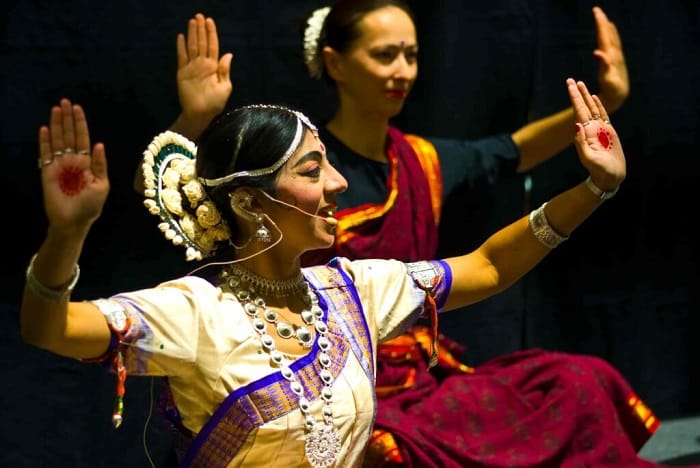The growth of music has led to an incredibly long tradition in India, tracing back to the earliest days where Hindustani and Carnatic music were introduced. Throughout successive Maurya and Gupta Empires, music continued to evolve and expand in India and Southeast Asia. To begin with, the Indian culture is one of the most ancient and diverse cultures in the world. India being an art-rich heritage, reflected in the Indian classical music essence where it brought many instruments and melodies.
Having said that, Indian music has developed through very complex interactions between different people of many races and cultures over several thousand years. Considering the major advances in music were made between the 13th and 18th centuries, Persian and Islamic influences diverged into two general traditions; being Hindustani music and Carnatic music.
Introduction to Indian Classical Music

Indian classical music is generally the most popular form of classical music after Western classical music. Historically, it has adopted and evolved with many regional styles among which the Bengali classical tradition. It is considered as a rich tradition that originated in South Asia dating back to sacred Vedic scriptures over 6,000 years ago. Now, it can be found in all corners of the world after its system’s development of musical notes and rhythmic cycles.
Passed down in an oral tradition, students can learn Indian classical music in many institutions and would spend many years with their ‘guru’. In this case, they develop a very special and spiritual bond while absorbing all aspects of the music along with its philosophical and moral principles that mold them for life. It should be mentioned that it has been documented and notated through ages; however, it is learned through observation, listening, and memory. On that account, Indian classical music has two main popular traditions which are the northern Hindustani music and southern Carnatic music. The following article will discuss both similarities and differences points between the two along with definitions for better understanding.
Definition of Hindustani Music
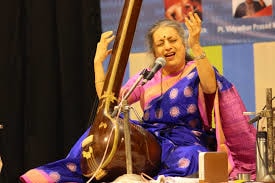
The origin of Hindustani Music can be traced back to the Delhi Sultanate and Amir Khusrow (1233- 1325 AD). The latter is a composer in Persian, Arabic, and Turkish, as well as Braj Bhasha. This composer is credited for systematizing a few aspects of Hindustani music, in addition to introducing several ragas such as Yaman Kalyan, Zeelaf, and Sarpada. In the 12th Century, this music underwent a Persian and central Asian impact that lasted through the Medieval period and spanned over 700 to 800 years. This resulted in the emergence of the Hindustani music which was mostly and predominantly present in North India.
Furthermore, Dhrupad and Dhamar are considered as the oldest root of Hindustani music, which is a creation of Swami Haridas. Over a period of time, Khyal, Thumri, Thappa Tirana, and so on developed as the distinct styles of Hindustani music; then further developed into Vocal & Instrumental Streams. One of the greatest names who influenced the Hindustani style heavily is Miyan Tansen.
Moreover, Hindustani can be divided into two types of music namely Classical and light classical. Regarding the standard classical Hindustani, it is stricter in the raga form whereas light classical creates room for interpretation and free nature. The Light classical type is usually descended from popular folk Indian music and mainly has a fast to medium tempo. In addition to that, the central notion in the Hindustani system of music is called ragas and is described as musical compositions able to induce certain moods or emotions. To explain, ragas have been investigated and proven to have distinct ragas that elicit distinct emotions.
Definition of Carnatic Music
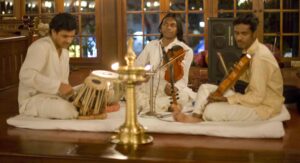
On broad terms, Carnatic music remained unaltered and stayed the exact same right from ancient times. It was mainly patronized by the local kings of Travancore’s Kingdom and the Kingdom of Mysore during the 18th through 20th centuries.
This Indian classical music subgenre is popular among the South Indian states of Tamil Nadu, Karnataka, Andhra Pradesh, and even Telangana. Purandar Das is regarded as the founding father of the Carnatic style of music. However, the credit for the Carnatic style’s development goes mainly to three musicians; namely, Tyagaraja, Shyama Shastri, and Muthuswami Dikshitar. These musicians are called the Triratna of Carnatic music who stood out from 1700 to 1850 AD. Besides them, three other exponents of Carnatic music were Kshetra Rajan, Swati Tirunal, Subramaniya Bharathi. All in all, they are all considered the seven great exponents of Carnatic music.
In general, traditional Carnatic music performance consists of a vocalist, a violinist, and a percussionist. With a strong emphasis on vocalist styling, this classical music genre can be more improvised so it is complex. This means that Carnatic music pushes heavily the ‘gayaki’ factor of music; i.e., the vocal aspect instead of the instrumental aspect. In addition, audience participation is strongly favored as “keeping the tala” which assists to keep time by feet and hand counts.
It should be noted that the vocal performance of the Carnatic music genre typically starts with a Varnum, which is a composition of three entities. The latter are called pallari, anupallavi, and chittaswaram. Also, they are followed by a one or two tempo building Kritan which are followed by thaalam (jor) and an alpana (alaap).
While the singer concentrates on improvising within the presented structure, he or she focuses on the notes of raga. To sum up, the Carnatic classical music is spirituality more of a focal point than in its Hindustani counterpart. In this case, the lyrics are sung in this style center around philosophical and devotional messages. Some of the Carnatic royalty are Syama Satri, Tyagaraja, and Mutuswamy Dikshitar.
The Similarities Between the Hindustani and Carnatic Music
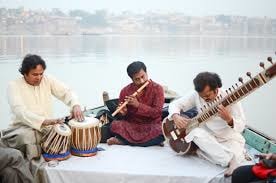
Both of the two Indian Classical music forms, Carnatic and Hindustani, have evolved over this long period of time and has undergone several changes through the fascinating journey in history. In the following, we present a list of concepts that both Hindustani and Carnatic music share in common;
- Although there are stylistic differences between the two, the basic elements of swara, raga, and tala remain the exact same as the foundation of both.
- Both of their music forms use the Taanpura to maintain Shruthi; thus, they are termed as monophonic
- The Hindustani music originated during the Vedic period, while Carnatic music originated in the Bhakti movement. Hence, both have a deep association with religion and spirituality
- Both of the Indian classical music evolved with Sanskrit language scripts in itself, and through Vedic traditions.
- Moreover, Sampoorna scale is found to be used in both of the Indian classical music systems to describe Janya Raga.
- In addition, the central notions in both these types are that of a melodic mode or raga, sung to a rhythmic cycle and/ or tala.
- Considering the Raga in both Hindustani and Carnatic music, both have many Raga Equivalents that exist within each. For instance, Hindustani Bilawal is Dheera Shankarabharanam in Carnatic, Hindusthani Yaman is Carnatic Kalyani, and Kaafi on Hindustani is equivalent to KaraharaPriya in Carnatic.
- Both Hindustani and Carnatic music have nava rasas or nine basic emotions; namely, love, disgust, humor, terror, wonder, anger, heroism, pathos, and serenity which are fundamental to all Indian aesthetics.
- Furthermore, both Hindustani and Carnatic music have basic 7 musical notes so-called swaras within an Octave (Western Music) or Sampoorna Scale also called Saptak (in Indian Classical Music) in order to define Janak Thaat (Janya Raga)
- Additionally, both of them use Tanpura with either one or two notes to represent base and pitch in Raga rendition. To further elaborate, Both Hindustani and Carnatic music have one dominant swara or vadi swar in each Raga.
- Unlike Western music where harmony is given more importance, Hindustani and Carnatic music styles give prime importance to melody.
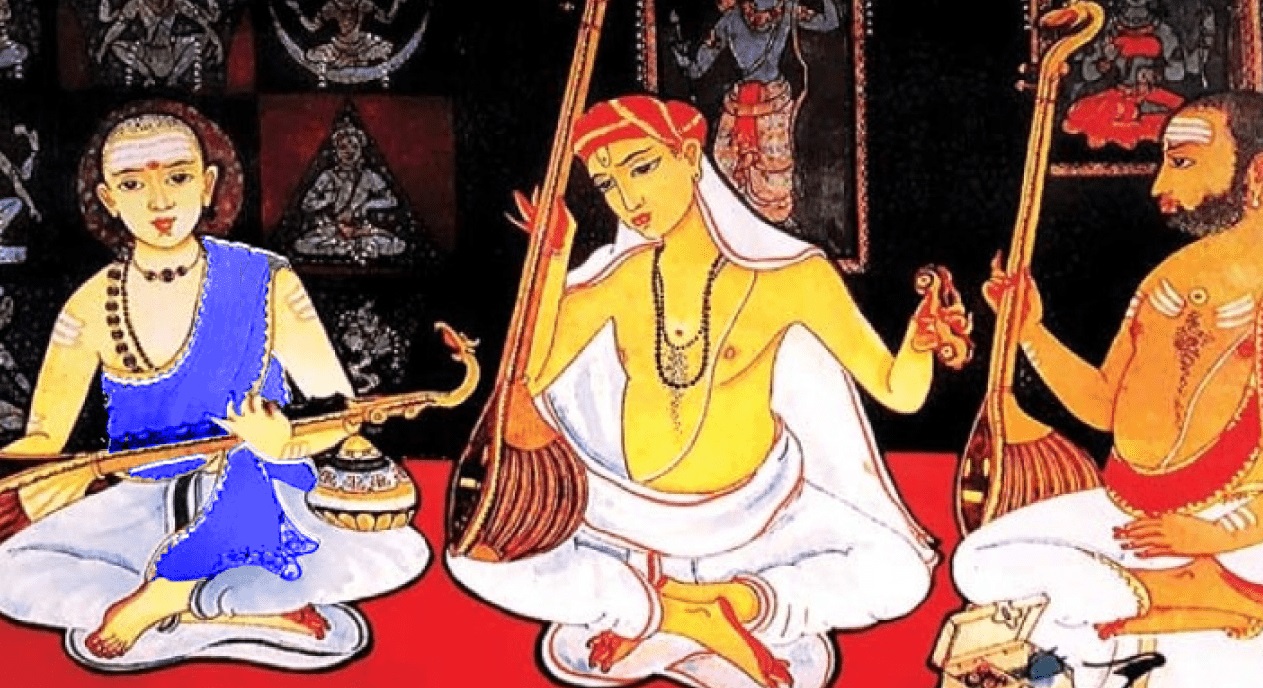
Hindustani and Carnatic Music are Similar in Many ways (Image From musicbot.in)
The Differences Between the Hindustani and Carnatic Music
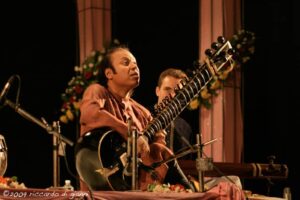
- As a start, Hindustani Music is an Indian classical school of Music that is present in North India. Whereas, the other school, Carnatic music is mainly practiced in Southern India.
- Concerning the origin of Hindustani music, it was developed during the Vedic period and it is older than Carnatic. It synthesizes with Islamic traditions, Vedic chants, and Persian Musiqu-e-Assil style. In contrast, Carnatic music developed during the Bhakti movement in the 15th and 16th centuries and got a boost in the 19th -20th century. This means that Carnatic music is comparatively pure.
- While the Hindustani music subgenre had a Persian influence in the vast Northern Geography of India, it underwent many changes. On the other hand, Carnatic music did not undergo much change.
- Furthermore, devotional and philosophical content is an essential element of Carnatic music. Whereas, Hindustani music possesses a very diverse content ranging from ghazal, kajiri, thumri to bhajans (social in nature or mythological)
- Also, Singers of Hindustani music have the freedom to improvise; i.e., it has a certain format of improvisation which is given more importance. While in Carnatic music, there is no freedom to improvise; meaning that composition is given more importance.
- Even the musical instruments appear to have a difference between the 2 music cultures. There are 6 major musical instruments used in Hindustani; namely, Tabla, Sarangi, Sitar, Santoor, Flute, and violin. The Carnatic music, on the other hand, uses veena, mandolin, mridangam, and jalatarangam, and so on.
- In regard to ragas, there are six major vocal forms of Hindustani music; namely, Dhrupad, khayal, Tarana, Thumri, Dadra, and Gazal. Whereas the Carnatic music embraces several varieties of about 72 ragas among which Alpana, Niraval, kalpanaswaram and Ragam Thana pallavi.
- The main emphasis in Hindustani music is on vocal music; i.e., the vocal-centric group is required while the instruments are only designed to accompany the singers. In contrast, Carnatic music focuses on both vocals and instruments as most compositions are to be sung, involving gayaki style.
- Hindustani music on one hand is based on rhythmic patterns (the concept of Laya), called taals. On the other hand, Carnatic music focuses its main emphasis is on the pitch (the concept of Sawara) when performing.
- In addition, Hindustani music has various gharanas such as Lucknow, Jaipur, Kirana, Agra, and so on. However, Carnatic music does not have such a thing as gharanas found.
- In past times, Hindustani Music has evolved for the purpose of entertainment; while the Carnatic Music style evolved for the purpose of devotion to gods (spiritual).
- In terms of song tempo, Hindustani music depends on expressing the emotion of the performer; therefore, it is of slow speed with long note values increasing in intensity. Meanwhile, in Carnatic music, the tempo is generally faster, remaining more, constant, with shorter note values. The latter means that it creates long slow tempo phases designing the structural features of a shorter piece.
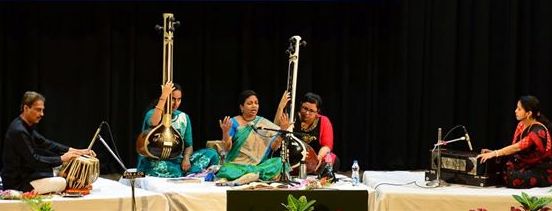
Hindustani and Carnatic Music: Know the Difference (Image From carnaticstudent.org)
To further illustrate the similarities and differences between both music subgenres (Hindustani and Carnatic), we summarized the main points in the following table:
|
Similarities |
|
|
|
|
Differences |
|
| Hindustani | Carnatic |
| North Indian origin | South Indian origin |
| Vedic period | Bhakti movement |
| Underwent changes | Did not go through changes |
| Diverse content | Devotional and philosophical content |
| Freedom to improvise | Composition is essential |
| Six major instruments (Tabla, Sarangi, Sitar, Santoor, Flute, and violin) | Different instruments (Veena, Mandolin, Mridangam, Jalatarangam, etc.) |
| Six major vocal forms (Dhrupad, khayal, Tarana, Thumri, Dadra and Gazals) | A variety of 72 ragas |
| Emphasis on vocal music | Emphasis on vocals and instruments |
| Various gharanas | No gharanas |
| Entertainment purpose | Spiritual purpose |
| A slow speed with long note values | Faster speed with shorter note values |
Indian traditional music has been passed on through generations and taught from a family to another. In fact, India is believed to possess a distinct sound and a pure authentic sound implemented by unique instruments producing great music. Today, Hindustani and Carnatic music styles are still playing an important role in uniting Indians by generating a nationalism feeling since the national movement. Alongside this, they are being practiced during festivals, stages, and in cinema. In conclusion, it is true to say that Indian music will continue to pave the way for all Indian culture authentic material and reach wider in the western world.
